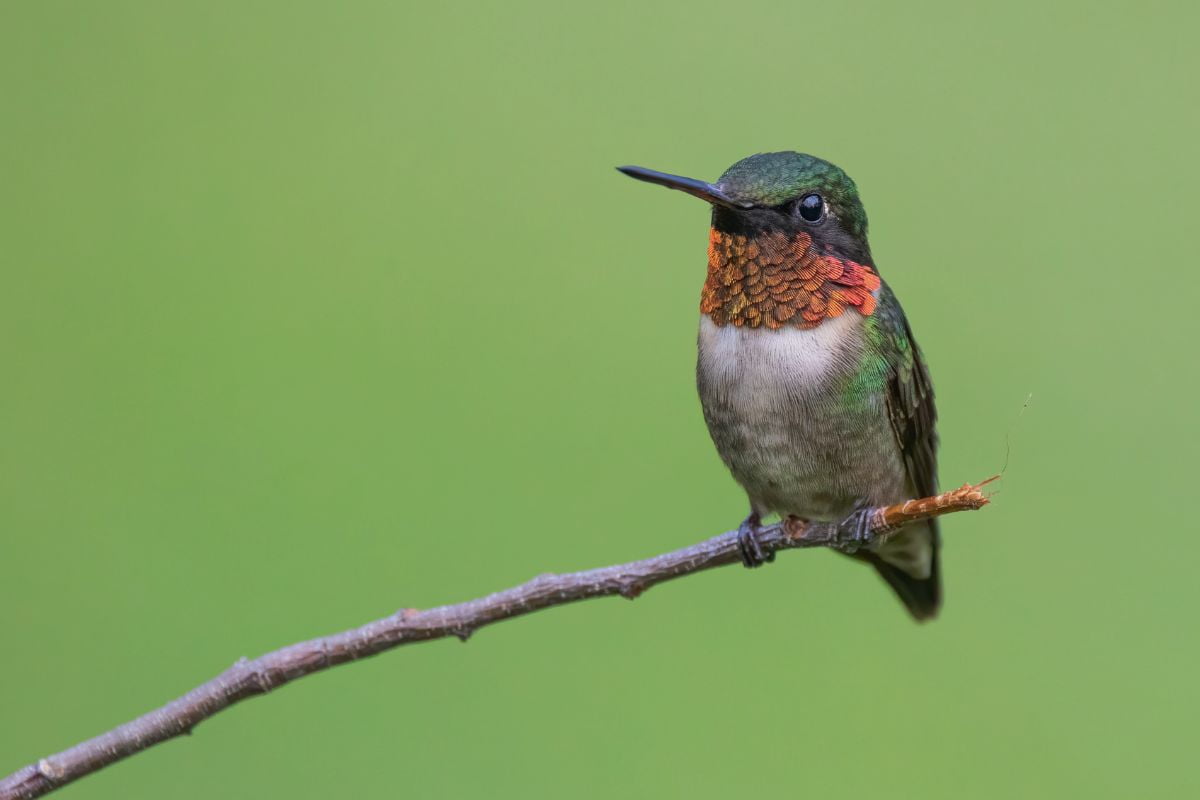Yes, hummingbirds are indeed present in New York! During the warmer months, you can spot the Ruby-throated Hummingbird, the only species of hummingbird that breeds in the eastern United States, in various parts of the state.
These captivating and small birds bring enchantment to gardens and natural spaces with their shimmering colors and impressive aerial maneuvers.
Exploring Hummingbirds in New York
In this article, we will delve into the world of hummingbirds in New York, including their distribution, preferred habitats, and tips on attracting them to your garden.
The Ruby-throated Hummingbird: New York’s Aerial Acrobat
The Ruby-throated Hummingbird is the exclusive hummingbird species frequently found in New York. These tiny birds measure only 7 to 9 centimeters in length and weigh a mere 3 to 4 grams. They are renowned for their stunning green and red feathers and their extraordinary ability to hover in place or fly in any direction, including upside-down!
After completing a challenging migration from their wintering grounds in Central America, these hummingbirds arrive in New York in the spring. During their time in the Empire State, they breed, raise their young, and feed voraciously to prepare for their long journey back south in the autumn.
Spotting Hummingbirds in New York
Ruby-throated Hummingbirds can be found throughout New York, from the bustling metropolis of New York City to the serene forests of the Adirondacks. They are most commonly seen in suburban gardens, parks, and wooded areas where there is an abundance of nectar-producing flowers and insects, which are their primary sources of food. While sightings cannot be guaranteed, some popular locations for observing hummingbirds in New York include Central Park in New York City, the New York Botanical Garden in the Bronx, and various nature reserves and parks across the state.
Creating an Ideal Habitat for Hummingbirds in Your Garden
If you want to attract Ruby-throated Hummingbirds to your garden, there are several essential factors to consider.
By planting flowers that are rich in nectar, providing a hummingbird feeder, offering perching and nesting sites, avoiding pesticides, and providing a water source, you can transform your outdoor space into a haven for hummingbirds.
- Plant Nectar-Rich Flowers: Hummingbirds are particularly attracted to brightly colored, tubular flowers that produce abundant nectar. Some popular choices include trumpet vine, bee balm, salvia, and fuchsia. Planting a variety of these flowers with different blooming times will ensure a continuous supply of nectar throughout the season.
- Provide a Hummingbird Feeder: A sugar-water feeder can be a valuable supplement to natural nectar sources, especially during periods of drought or when flowers are scarce. Remember to clean and refill the feeder regularly to prevent the growth of harmful bacteria.
- Offer Perching and Nesting Sites: Hummingbirds need places to rest and build their nests. Provide a variety of shrubs and small trees with dense foliage, as well as vines and other vertical structures for them to perch on.
- Avoid Pesticides: Many insects, including small flying insects and spiders, are essential parts of the hummingbird’s diet. By avoiding the use of pesticides in your garden, you will not only protect the hummingbirds but also promote a healthy ecosystem that supports a diverse range of wildlife.
- Provide a Water Source: Hummingbirds need to drink and bathe regularly to maintain their health. A shallow dish with clean, fresh water or a mister can be an attractive addition to your garden for these birds.
Conserving Hummingbirds and Their Habitats
While Ruby-throated Hummingbirds are not currently classified as endangered, it is crucial to take steps to protect their habitats and support conservation efforts.
Habitat loss, pesticide use, and climate change all pose significant threats to these tiny birds. By working together, we can help ensure their survival for future generations to appreciate.
- Support Local Conservation Initiatives: Join or donate to local conservation organizations that work to protect hummingbird habitats and other vital ecosystems in New York and beyond.
- Advocate for Sustainable Land Use Practices: Encourage local policymakers to adopt sustainable land use practices, such as preserving green spaces and promoting native plant gardening, to safeguard hummingbird habitats and other wildlife.
- Educate Others: Share your knowledge about hummingbirds and their conservation needs with friends, family, and neighbors. By raising awareness, you can help build a community of people dedicated to preserving these beautiful birds and their habitats.
- Be a Responsible Birdwatcher: When observing hummingbirds in the wild, always maintain a respectful distance and avoid disturbing their nests or feeding sites. Stick to designated trails and follow the guidance of local wildlife authorities to minimize your impact on the environment.
Discover the Wonder of Hummingbirds in New York
Hummingbirds in New York offer a rare glimpse into a world of extraordinary beauty and grace. These aerial acrobats captivate our hearts and minds with their incredible flight abilities and iridescent colors, reminding us of the many wonders that nature has to offer. By creating welcoming spaces for hummingbirds in our gardens, supporting conservation efforts, and fostering a love for these enchanting creatures, we can all play a part in preserving the rich biodiversity of our planet.
So, the next time you find yourself in the Empire State during the warmer months, keep your eyes peeled for a flash of green and red darting through the air. It might just be one of New York’s enchanting Ruby-throated Hummingbirds, offering a moment of awe and delight in our fast-paced, modern world.
